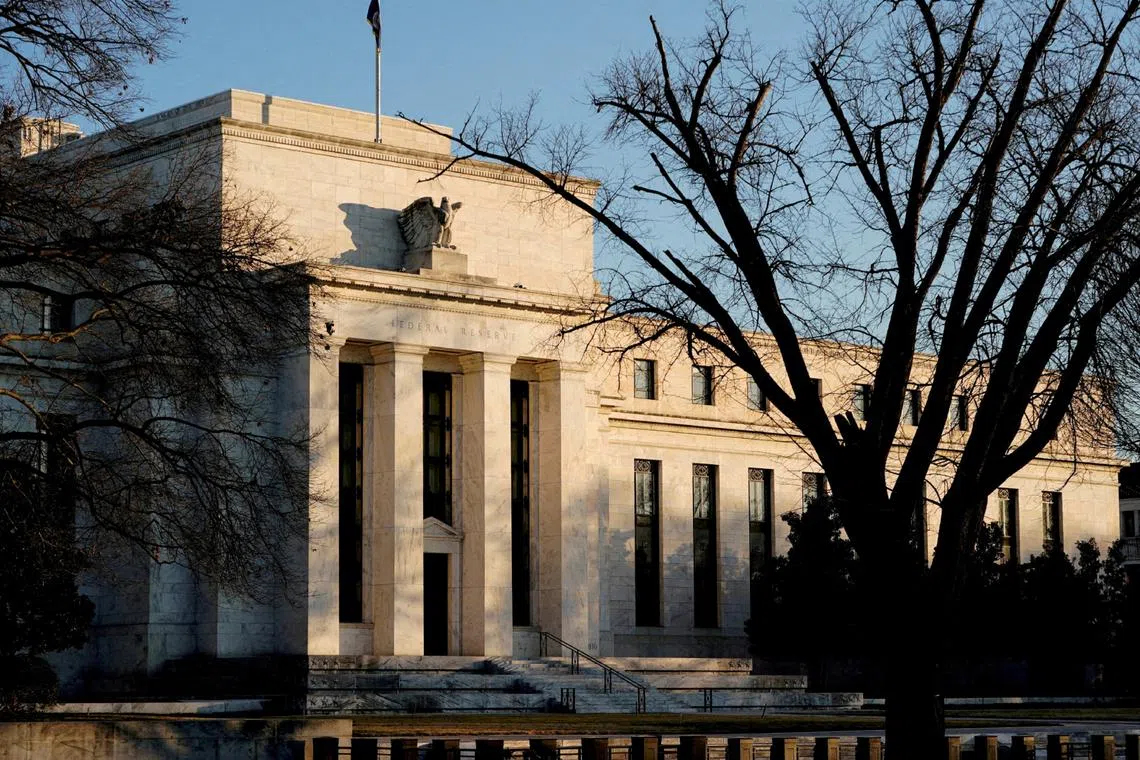With rates set to fall, what does it mean for bonds?
Sign up now: Get ST's newsletters delivered to your inbox

The market view is that the Fed needs to be more confident that inflation is heading back down to 2 per cent before it acts.
PHOTO: REUTERS
Follow topic:
SINGAPORE – While United States interest rates have likely hit their peak – the Federal Reserve has not hiked rates since July 2023 – there is uncertainty over the pace and size of the potential cuts in 2024.
Rates have held steady at 5.25 per cent to 5.5 per cent. Fed chairman Jerome Powell has said there would likely not be enough data by the March meeting to be sure they have made enough progress against inflation.
The market view is that the Fed needs to be more confident that inflation is heading back down to 2 per cent before it acts. This is especially so as the latest US non-farm payroll jobs report for January added 353,000 jobs, higher than even the highest economist estimate of 300,000, showing that the US job market is still resilient
Mr William Goh, portfolio manager for fixed income at HSBC Asset Management (Singapore), said: “Our view is that the Fed will likely start cutting rates in the second quarter of 2024.”
Here are some of the ways investors can manage the transition to a lower-yield environment.
How a duration barbell strategy can help
HSBC Asset Management looked at how rising rates and falling rates affect a duration barbell strategy implemented using both short-duration and long-duration bonds. For illustration purposes, we can look at a long-duration portfolio of around 5.92 years and a short-duration portfolio of around 0.32 year.
If interest rates fall by 25 basis points, the short-duration portfolio will gain only 0.09 per cent, while the long-duration portfolio will gain 1.56 per cent. The difference is bigger for larger interest rate moves. A 100-basis-point decrease in interest rates will see the same short-duration portfolio gain 0.37 per cent, whereas the long-duration portfolio will gain a much higher 6.09 per cent.
Mr Goh says an incremental allocation towards a longer-duration portfolio can be considered – the proportion depends on one’s view – while enjoying the higher yield at the short end of the curve. This will help gradually transition to a longer-duration portfolio positioning in an uncertain market environment.
The analysis from HSBC also illustrates the trade-off between having higher portfolio yields and greater capital appreciation under HSBC Asset Management’s 2024 interest rate forecast scenario.
A portfolio that is fully invested in short-duration bonds (with a relatively high portfolio yield of around 5.87 per cent) may experience only 0.33 per cent in capital appreciation. Take another combination, where 60 per cent is in the short-duration portfolio and 40 per cent in a long-duration portfolio. Here, although the portfolio yield is slightly lower at 5.39 per cent, the value of the portfolio may increase by 0.51 per cent.
Mr Goh noted: “Perfectly timing a move into a longer-duration bond portfolio would be difficult due to the uncertainty of when and how rates would move. However, a duration barbell approach could help to mitigate this uncertainty by gradually moving into a long-duration bond portfolio without giving up too much yield along the way.”
This can be seen from HSBC Asset Management’s analysis of BBB-rated US corporate bonds, where the yield curve was relatively flat as at Dec 31, 2023.
Thus, a longer-duration bond portfolio would have the added benefit of providing greater capital appreciation when interest rates fall, because bond prices move inversely to interest rates, and proportionally with duration – that is, the larger the bond duration, the greater the bond price movement.
How Singdollar bonds might help to build a defensive approach
Mr Goh said the Singapore bond market may be another option to consider. Singapore dollar bonds “are generally less volatile than US Treasury bonds”, he said. “That’s mainly due to the nature of the Singdollar bond market, which is smaller, less liquid, and benefits from a larger proportion of hold-to-maturity segment, which also means a smaller proportion exposed to speculation.”
Hence, for a more defensive approach, when increasing the proportion of long-duration bonds in their portfolio, Singdollar bonds can be considered instead of US dollar bonds.
Get indirect forex exposure through the Singdollar
The Monetary Authority of Singapore does not control or target interest rates. Instead, it allows the Singapore dollar to float against an undisclosed trade-weighted basket of foreign currencies within a policy band.
By holding Singdollars, this can be seen as an indirect way of getting exposure to a more diversified basket of foreign currencies, rather than just a single foreign currency.
The desired overall currency exposure can then be fine-tuned by adjusting the portfolio weightage of these individual foreign currencies after accounting for indirect exposure via the Singdollar.
Note: The duration barbell strategy mentioned in this article conceptualises a simultaneous allocation to both the short and long ends of the bond duration spectrum to capture both the relatively higher yields of short-term bonds (compared with longer-term bonds) and the capital appreciation potential of longer-term bonds when interest rates fall.
Ideally, both ends of the “barbell” should be well diversified, with the portfolio durations of the short and long ends of the “barbell” being less than one year and more than five years, respectively.

